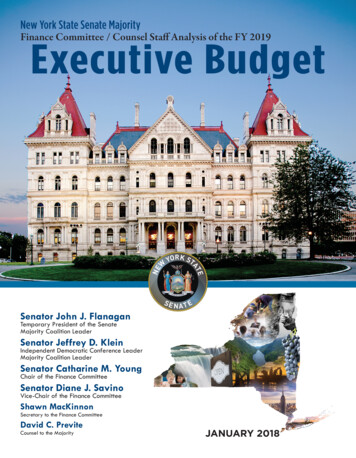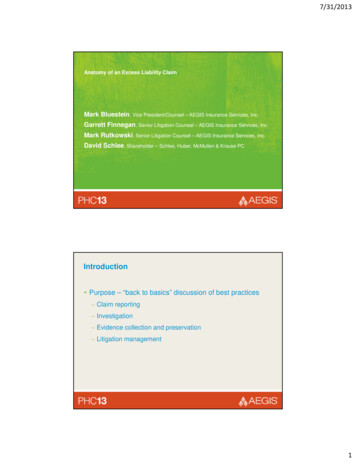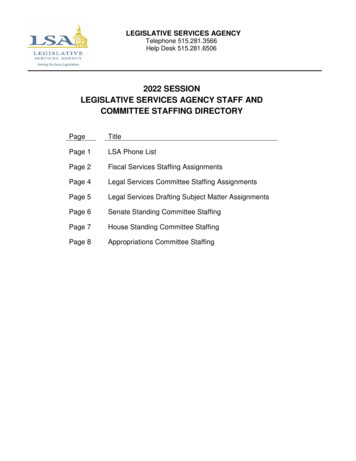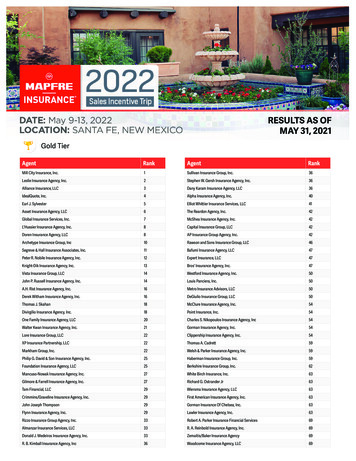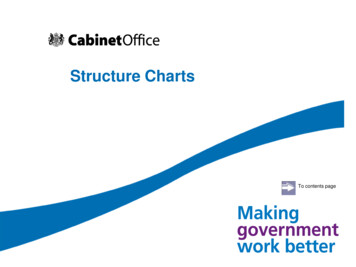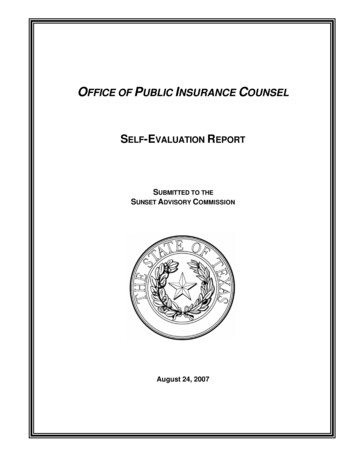
Transcription
OFFICE OF PUBLIC INSURANCE COUNSELSELF-EVALUATION REPORTSUBMITTED TO THESUNSET ADVISORY COMMISSIONAugust 24, 2007
Table of ContentsI.Agency Contact Information .1II.Key Functions and Performance .1III.History and Major Events .8IV.Policymaking Structure.11V.Funding .12VI.Organization.15VII.Guide to Agency Programs.17VIII.Statutory Authority and Recent Legislation.32IX.Policy Issues .39X.Other Contacts .42XI.Additional Information.45XII.Agency Comments .49
OFFICE OF PUBLIC INSURANCE COUNSELSELF-EVALUATION REPORTI. Agency Contact InformationA.Please fill in the following chart.Office of Public Insurance CounselExhibit 1: Agency ContactsNameAgency HeadAgency’s SunsetLiaisonRod BordelonTeresa HankinsAddressTelephone &Fax Numbers333 Guadalupe, Suite. 3-120,Austin, TX 78701322-4143 (Ph)333 Guadalupe, Suite. 3-120,Austin, TX 78701322-4107 (Ph)322-4148 (Fax)322-4148 (Fax)E-mail te.tx.usII. Key Functions and PerformanceProvide the following information about the overall operations of your agency. More detailed information aboutindividual programs will be requested in a later section.A.Provide an overview of your agency’s mission, objectives, and key functions.MISSIONThe mission of the Office of Public Insurance Counsel (OPIC) is to represent the interests of consumers ininsurance matters. This means advocating fairness and stability in insurance rates and coverage; promoting publicunderstanding of insurance matters; working to make the overall insurance market more responsive to consumers;and ensuring consumers receive the services they have purchased.OPIC is authorized by statute to assess the impact of insurance rates, rules, and forms on insurance consumersand directed to act as an advocate of positions that are advantageous to a substantial number of consumers.Office of Public Insurance Counsel (359)Self-Evaluation Report, August 2007-1-
The agency intervenes as a party and presents actuarial and economic evidence in industry-wide rate hearings andindividual rate filings before the Commissioner of Insurance and the State Office of Administrative Hearings.OPIC provides proposals and analysis to the Commissioner of Insurance on rules and forms regulated by theTexas Department of Insurance.OBJECTIVESEnsure fair rates and adequate rules and policy forms to protect Texas insurance consumersEach year OPIC represents consumers in all industry-wide rate hearings and in at least fifty percent of rate filingsand rule hearings that have a significant impact on Texas insurance consumers to ensure that insurance rates inTexas are fair and that rules are adequate to protect Texas insurance consumers.Provide information to insurance consumers regarding insurance coverage and marketsThe agency uses efficient means to provide information to insurance consumers about insurance coverage and theinsurance marketplace and participates in public forums to obtain information in order to formulate positionsadvantageous to insurance consumers.KEY FUNCTIONSRepresent insurance consumers in rate, rule and policy form hearingsOPIC represents consumers as a class on matters involving rates, rules, and forms affecting various personal linessuch as property and casualty, title, and credit insurance, and on matters involving rules and forms for life,accident, and health insurance. OPIC is authorized by statute to assess the impact of insurance rates, rules andforms on insurance consumers and directed to act as an advocate of positions that are advantageous to asubstantial number of consumers.Provide consumers with information to make informed choicesOPIC issues annual consumer report cards on Health Maintenance Organizations. Mandated by the 75thLegislature, the consumer report card provides information to consumers about the various HMO productsavailable in the state. After the legislature restructured the Health and Human Services Commission in 2003, OPICalso began publishing the “Guide to Texas HMO Quality”, a technical report geared toward employers andstatisticians previously published by the Texas Health Care Information Council.OPIC has produced consumer bills of rights for personal automobile, homeowners, and credit insurance.Mandated by the 72nd Legislature, the bills of rights are designed to inform consumers of their specific rights invarious lines of personal insurance.Beginning in September 2008, the agency will partner with the Department of Insurance to produce a websitecombining consumer information produced by the agencies as well as adding new information as required by SB611 passed by the 80th Legislature.The agency is also required by statute to recommend to the Commissioner of Insurance public members to sit onvarious boards and committees such as the Texas Automobile Insurance Plan Association Governing Board andthe Board of Directors for the Texas Windstorm Insurance Association.Office of Public Insurance Counsel (359)Self-Evaluation Report, August 2007-2-
B.Do each of your key functions continue to serve a clear and ongoing objective? Explain why eachof these functions is still needed. What harm would come from no longer performing thesefunctions?Represent insurance consumers in rate, rule and policy form hearingsHaving OPIC represent insurance consumers in rate, rule, and policy form hearings continues to be a necessaryand vital part of insurance regulation. The Department of Insurance (TDI) is charged with regulating theinsurance industry and marketplace as a whole and cannot focus solely on the needs of policyholders. InsteadTDI must balance the needs of insurance companies against the needs of insurance consumers as well as otherswho benefit from insurance payments. The department receives a great deal of input from the insurance industry,including the testimony of expert witnesses and representation by experienced attorneys. In order for theCommissioner of Insurance to have all the evidence necessary to make informed and fair decisions, it is necessaryfor consumers’ interests to be similarly represented. OPIC provides that representation by hiring staff attorneys,statisticians, and researchers, as well as contracting with expert witnesses in contested evidentiary hearingsProvide consumers with information to make informed choicesOPIC’s role in exchanging information with consumers continues to be necessary both from the agencyperspective and to ensure that consumers have accurate information in specific areas. The information theagency provides to consumers is targeted to issues where informational gaps exist and consumers are particularlyvulnerable. The bills of rights provide practical information that consumers can use to deal with issues that areoften areas of dispute with an insurance company. The HMO report card is especially valuable to consumers whoare enrolling, or considering a change, in their health care plan. Included in the report card is information on theservices provided by each HMO, the quality of care provided, the results of a consumer satisfaction survey,costs, complaints, and other helpful information. Additional information provided on the agency’s website, suchas the interactive comparison chart for homeowners policies, helps consumers make the transition from a verylimited number of state-promulgated policy forms to a multitude of policy forms filed by insurance companies.C.What evidence can your agency provide to show your overall effectiveness and efficiency inmeeting your objectives?OPIC annually reviews hundreds of rate filings and has worked successfully against rate increases proposed bythe insurance industry. During the period from 2004-2007, OPIC intervened in 75 cases resulting in lower ratesfor consumers and/or other policyholder benefits. These cases involved homeowners insurance, personalautomobile insurance and workers compensation insurance resulting in estimated savings to consumers of 654,404,258. In addition, OPIC participated in statewide rate cases involving the Texas Windstorm InsuranceAssociation (TWIA), the Texas Automobile Insurance Plan Association (TAIPA), as well as title insurance andcredit insurance. OPIC's participation in these cases resulted in rate decreases or reductions in proposed levels ofrate increase estimated at 196,496,863.Office of Public Insurance Counsel (359)Self-Evaluation Report, August 2007-3-
The agency has also worked to prevent or limit the reduction of coverage available to insurance consumers.During the period from 2004-2007, OPIC participated in 144 rulemaking proceedings, including policy formapprovals, resulting in preservation of coverage or other benefits for consumers. With the approval of nationalforms and other optional forms for homeowners and automobile insurance, OPIC negotiated additional coveragethat was not offered in initial company filings. Additionally, the agency obtained improved disclosure associatedwith these forms and rules prohibiting unfair discrimination. OPIC was instrumental in negotiating protections forconsumers when water damage coverage was curtailed to reverse an availability and affordability crisis in thehomeowners market. When hurricane damage forced homeowners out of their homes and some consumers werenot reimbursed for additional living expenses, OPIC requested a market conduct investigation, resulting inadditional payments to consumers and a temporary restraining order against one of the top homeowners insurancecompanies in the State. OPIC worked directly with insurance companies and with TDI staff to revise or removeoverly restrictive language in automobile policies regarding arbitration, voidance of coverage, and selection of arepair shop. To protect health insurance consumers from payment delays that could lead to treatment delays,OPIC successfully argued to shorten the time insurance companies could take to respond to requests forverification of coverage from the initially proposed 15 days to 72 hours. In conjunction with the establishment ofhigh deductible health plans, OPIC successfully argued for language that protected benefits and services that fallwithin the federal safe harbor provisions of the IRS code. OPIC was also responsible for reducing a proposedsurcharge for certain policyholders living along the coast and for reducing proposed fees for a homeownersinspection program.D.Does your agency’s enabling law continue to correctly reflect your mission, objectives, andapproach to performing your functions? Have you recommended changes to the Legislature inthe past to improve your agency's operations? If so, explain. Were the changes adopted?The agency’s enabling law continues to reflect the agency’s mission, objectives and approach to performing itsfunctions. The agency has broad authority to advocate for insurance consumers in the areas that are regulated bythe Department of Insurance.E.Do any of your agency’s functions overlap or duplicate those of another state or federal agency?Explain if, and why, each of your key functions is most appropriately placed within your agency.How do you ensure against duplication with other related agencies?Both OPIC and TDI staff make rate recommendations to the Commissioner of Insurance. The recommendationsmade by TDI staff generally provide evidence that supports previous decisions made by the commissioner.OPIC’s recommendations are necessary to bring into evidence new rating issues that should be considered by thecommissioner. OPIC’s analysis provides a specific rate recommendation that represents the lowest rate thatmeets rating standards in order to fully represent consumers interests. TDI staff often presents only a range ofrates that may be considered reasonable. Additionally, OPIC’s analysis is more critical, and is necessary tocounter the professional testimony, of insurance industry experts.Office of Public Insurance Counsel (359)Self-Evaluation Report, August 2007-4-
Both OPIC and the Department of Insurance provide information to insurance consumers. Any duplication hasbeen eliminated by OPIC providing input to the department on its consumer brochures instead of producing itsown consumer brochures. The consumer publications produced by OPIC are generally limited to those specifiedin statute, i.e. the HMO reports, consumer bills of rights, and reports on insurance companies’ underwritingguidelines. In each instance OPIC is best suited to provide the information because of the agency’s duty todirectly represent insurance consumers. Occasionally, OPIC produces a specific publication to fill a gap inconsumer knowledge such as the homeowners insurance policy form comparison chart. In this instance,consumers were in need of a tool to help them make the transition from a market in which all homeownersinsurance policy forms were promulgated by the Department of Insurance to one in which insurers filednumerous forms with varying provisions. In accordance with SB 611 passed by the 80th Legislature this tool, aswell as other consumer information produced by OPIC and TDI, will be included in a website produced jointly bythe two agencies. TDI’s approach tends to be more neutral with regard to the marketplace in general and is lessdirected to the specific informational needs of consumers.Both OPIC and the Health and Human Services Commission (HHSC) have statutory authority regarding providinginformation on HMOs. OPIC is charged with reporting on the performance of HMOs in the state. HHSC isauthorized to make available HMO quality data. Since the initial passage of the laws requiring this reporting, inaccordance with its specific mandate, OPIC has issued annual consumer report cards on Health MaintenanceOrganizations. After the legislature restructured the Health and Human Services Commission in 2003, OPICentered into an agreement with HHSC and began publishing the “Guide to Texas HMO Quality”, a technical reportgeared toward employers and statisticians previously published by the Texas Health Care Information Council.Since these publications directly report on consumer satisfaction with HMOs and the services consumers arereceiving from HMOs, it is appropriate that the agency that directly represents insurance consumers determine thecontent and produce these reports. HHSC’s approach tends to be more neutral with regard to the marketplace ingeneral and is less directed to the specific informational needs of insurance consumers.F.In general, how do other states carry out similar functions?The regulation of insurance rates, rules and policy forms varies by state as does the existence or form ofconsumer representation. Other states generally do not have an agency similar to OPIC. States with anindependent insurance advocate include Florida which has an insurance consumer advocate appointed separatelyfrom the Insurance Commissioner and South Carolina which has an independent Department of Consumer Affairsthat represents insurance policyholders in rate cases as an intervener. Bills have been filed recently to establishsimilar offices in Illinois, Iowa, Pennsylvania and New York. States such as South Carolina, Massachusetts,Rhode Island, and Virginia have insurance consumer representation within the Attorney General’s office.California has a system whereby intervening consumer advocates are reimbursed by the insurance companywhose filing is at issue in the hearing. Expenses are approved by the Insurance Commissioner for expertwitnesses if the intervening party makes a substantial contribution to the case, irrespective of any quantifiedsavings.Office of Public Insurance Counsel (359)Self-Evaluation Report, August 2007-5-
G. What key obstacles impair your agency’s ability to achieve its objectives?OPIC’s right to a contested case hearing on rate filings that are deemed excessive by the Public Counsel needs tobe strengthened. When the legislature changed the rating structure in the 78th Legislative session (SB 14),the new procedure omitted OPIC’s absolute right to require a hearing on a filing if an agreement with thecompany could not be reached. In addition, an OPIC rate hearing petition, if granted, requires a hearing to be heldwithin 30 days of the petition filing date. Since this deadline does not allow enough time to prepare a contestedcase, OPIC must rely on the Commissioner to disapprove a filing or set a hearing.H.Discuss any changes that could impact your agency’s key functions in the future (e.g.,changes in federal law or outstanding court cases).Unlike many consumer products, insurance is primarily regulated by the states. In 1944, the United StatesSupreme Court ruled that the insurance industry should be subject to federal jurisdiction because the industrytakes part in interstate commerce. In response to that ruling, in 1945 Congress passed the McCarran-FergusonAct that exempts insurance from federal antitrust laws with some exceptions. With the passage of the McCarranFerguson Act, regulation of insurance was placed in the hands of the states. However, in spite of McCarranFerguson, federal actions have and will continue to affect the insurance industry and require state action.Currently, Congress is considering legislation that would remove significant insurance regulatory authority fromthe states and substitute federal oversight.At the state level, the most significant factor affecting the future role of OPIC is the implementation of recentlegislation that has increased the level of rate regulation for residential property and automobile insurance.Insurance companies previously exempt from rate regulation are now subject to filing requirements and OPIC isreviewing many more filings than before. In addition, the recent passage of legislation requiring OPIC and TDI toproduce a joint consumer website will require OPIC to invest more time and resources in developing informationalresources for consumers.Numerous insurance bills which passed in the 80th Legislative session must be implemented in the near future.Examples include bills relating to workers compensation, the addition of non-insurance benefits to certaininsurance products, certain mandated coverages, reporting of claim information, advertising, refunds of excessiveor unfairly discriminatory premium, suitability in annuity transactions, replacement of certain life insurancepolicies, title insurance, and prior approval of property and casualty insurance rates under certain circumstances.OPIC participates in the implementation process by analyzing proposed rules and recommending any neededchanges to the Commissioner of Insurance.Office of Public Insurance Counsel (359)Self-Evaluation Report, August 2007-6-
I.What are your agency’s biggest opportunities for improvement in the future?New requirements due to the passage of SB 611 in the 80th Legislative session will provide an enhanced role forOPIC in developing consumer information.With the passage of time since the Legislature introduced additional flexibility into the regulatory system, both theplusses and minuses of the new system are more apparent. This provides an opportunity to improve theprocedures for both rate and rule filings. The procedure to send rate filings to hearing based on OPIC’s objectionneeds to be strengthened either through legislation or by agreement with TDI. For form filings, the procedure toreview filings in effect and withdraw approval if problems exist needs improvement. One ongoing initiative willmove toward reviewing rate filings in an electronic format, thereby reducing the time needed to process and copyvoluminous filings.The passage of SB 1731 by the 80th Legislature, while it does not specifically include OPIC, may provide anopportunity for expansion of the HMO report cards currently produced by the agency. This legislation requiresTDI to collect from preferred provider organizations (PPOs) data which has not been available previously. OPICis currently working with TDI to implement the data collection. Including PPO data in the report cards couldenhance their value to consumers.J. In the following chart, provide information regarding your agency’s key performancemeasures included in your appropriations bill pattern, including outcome, input, efficiency, andexplanatory measures.Office of Public Insurance CounselExhibit 2: Key Performance Measures, Fiscal Year 2006FY 2006Key Performance MeasuresFY 2006ActualTargetPerformanceNumber of Industry-wide Rate Hearings in Which OPIC32Participated (1)Number of Analyzed Rate Filings in Which OPICParticipated3232Number of Rulemaking Proceedings in Which OPICParticipated4037Number of Report Cards and Publications Produced andDistributed175,000870,454Number of Press Releases Produced and Interviews3822Given and Newspaper Op-ed Columns Produced (2)(1)(2)FY 2006% of AnnualTarget66.67%100%92.50%497.40%57.89%The words “industry-wide” were removed from this measure for the FY 2008-2009 biennium.This measure was combined with another non-key measure for the FY 2008-2009 biennium and reads asfollows: Total Number of Public Presentations or Communications by OPIC.Office of Public Insurance Counsel (359)Self-Evaluation Report, August 2007-7-
III. History and Major EventsProvide a timeline of your agency’s history, and key events, including:ΧΧΧΧΧΧΧthe date your agency was established;the original purpose and responsibilities of your agency;major changes in responsibilities or statutory authority;changes to your policymaking body’s name or composition;significant changes in state/federal legislation, mandates, or funding;significant state/federal litigation that specifically affects your agency’s operations; andkey changes in your agency’s organization (e.g., a major reorganization of the agency’s divisionsor program areas).History and Major Events1987thThe 70 Legislature creates the Office of Public Insurance Counsel’s (OPIC’s) predecessor, the Officeof Consumer Protection (OCP). The OCP is set up as a division within the State Board of Insurance(SBI) to represent the interests of property and casualty insurance consumers as a class in mattersaffecting rates, rules and forms. The director of the OCP, or Public Insurance Counsel, is appointed bythe Governor and confirmed by the Senate.1991 The 72nd Legislature passes an omnibus insurance regulation bill. This legislation creates the Office of Public Insurance Counsel (OPIC) to replace the OCP.Designated as an independent state agency, OPIC is charged with representing Texas consumers as aclass regarding insurance related issues. OPIC’s purview is expanded to include all lines ofinsurance. OPIC’s duties are expanded to include matters involving rules for life, health and accident insuranceand matters involving rates, rules and forms for all other lines of insurance. OPIC is required toproduce consumer bills of rights for personal lines including personal automobile, homeowners andcredit insurance. A new flex band rating system is established. Under this system, the SBI sets a “benchmark” rateand individual companies are allowed to “flex” within a band set by the SBI without prior approval.OPIC is a statutory party to the annual benchmark hearings. SBI is required to continue promulgating policy forms for use in Texas for both residential propertyand personal automobile insurance, and is authorized for the first time to adopt policy forms filed bya national organization of insurance companies or similar organization. The coverage in these filedpolicies must provide coverage equivalent to the coverage provided by the forms promulgated by theOffice of Public Insurance Counsel (359)Self-Evaluation Report, August 2007-8-
SBI, and OPIC is charged with reviewing and advocating for changes to these forms to maintainequivalency.19931995 The Public Insurance Counsel is also statutorily required to serve on the board of directors for theTexas Certified Self-Insurer Guaranty Association. Prior to this, the Public Counsel for the OCPserved on the board. OPIC is authorized to nominate the public members to serve on the board of directors for TexasWindstorm Insurance Association (TWIA).Following Sunset Review in 1991, the 73rd Legislature passes another omnibus insurance bill. The SBI is restructured as the Texas Department of Insurance (TDI) and the authority of theCommissioner of Insurance is increased. The flex band system is continued but the annual ratehearings are moved to the State Office of Administrative Hearing (SOAH) with the InsuranceCommissioner being the final arbiter. OPIC continues to act as the legal advocate for insuranceconsumers before SOAH. OPIC is given the authority to request underwriting guidelines directly from insurance companies.While OPIC is statutorily prohibited from releasing these guidelines because of their confidentiality,OPIC is authorized to disclose a summary that does not directly identify an individual company’sunderwriting practices. Title insurance rate hearing is changed from an annual hearing to a biennial hearing. The Texas Automobile Insurance Plan (TAIP) is restructured as the Texas Automobile InsurancePlan Association (TAIPA). OPIC is authorized to nominate the public members to serve on theTAIPA Governing Committee.The 74th Legislature passes legislation that statutorily sets the percentage by which a company can “flex”above or below the benchmark rate set by TDI to 30 percent. OPIC remains a party to the annualbenchmark hearings by statute.Public Counsel Rod Bordelon begins a two year term on the board of directors for the Texas SurplusLines Stamping Office and on the board of directors for the Texas Workers Compensation InsuranceFacility.1997The 75th Legislature mandates OPIC to develop a report card on health maintenance organizations(HMOs) that provides comparative information to consumers about the various HMO products availablein Texas.1998OPIC publishes the first HMO Report Card.2001An unexpected rise in the number of water damage claims involving mold causes many companies tostop writing new business in Texas. TDI holds stakeholder hearings across the state to gain a better understanding of the reasons for therise in claims. Public Counsel Rod Bordelon testifies and addresses the stakeholders at every hearing.Office of Public Insurance Counsel (359)Self-Evaluation Report, August 2007-9-
20022003 OPIC helps draft best practices for the insurance industry, adjusters, remediators, and consumers tohelp mitigate water damage claims. OPIC participates in several meetings at the Texas Department of Health (TDH) in whic h the IndoorAir Quality Program of TDH was working on updating their consumer guide.Under the policy form statutory provisions enacted by the 72nd Legislature, Insurance Commissioner JoseMontemayor approves the first residential property policy form not promulgated by TDI for use inTexas. Companies begin to file their own national forms for approval. OPIC negotiates changes to several policy forms benefiting consumers, specifically concerningcoverage for damage caused by water. OPIC places a comparison chart on its website to help consumers understand the differencesbetween these policies. OPIC petitions TDI and successfully negotiates rules restricting insurers’ use of water damage claimhistory as an underwriting guideline.The 78th Legislature passes a comprehensive insurance bill that significantly changes the insuranceregulatory environment regarding residential property and personal automobile insurance. Insurance rates are to be filed under a file and use system and the flex band system is abolished.Under file and use, a company is authorized to use a rate as soon as it is filed with TDI withouthaving to wait for the rate to be approved by the Commissioner. Many previously unregulatedcompanies are now subject to regulation, and OPIC begins to review many additional filings andobject to those deemed excessive. Insurance companies are allowed to file their own policy forms for approval by the InsuranceCommissioner. Previously, companies had to use either a promulgated form or a form approvedunder the provisions passed by the 72nd Legislature. Many companies that were not previouslyauthorized to file their own policy forms begin to do so, and OPIC begins to review many additionalfilings and object and negotiate changes to terms deemed overly restrictive or misleading. OPIC’swebsite is expanded to include an interactive comparison chart in which the consumer can chooseboth company and coverages to compare. As part of this legislation, the Property and Casualty Oversight Committee is created to monitor theprogress of this legislation. The Committee is composed of 6 legislators and the Public InsuranceCounsel.The 78th Legislature also creates Texas Group Self-Insurance Guaranty Association Advisory Committeeof which the Public Insurance Counsel is a member. The purpose of
automobile insurance and workers compensation insurance resulting in estimated savings to consumers of 654,404,258. In addition, OPIC participated in statewide rate cases involving the Texas Windstorm Insurance Association (TWIA), the Texas Automobile Insurance Plan Association (TAIPA), as well as title insurance and credit insurance.
